How gift retailer creates ideal boxes and baskets
March 11, 2015
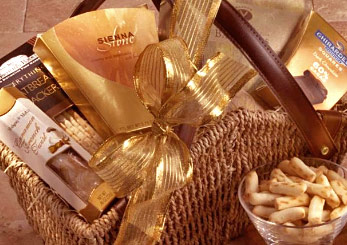
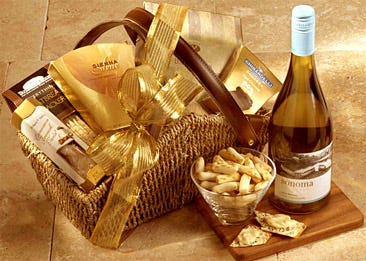
1-800 Flowers basket 1
Packaged goods companies that sell through multiple channels, including major retailers as well as direct-to-consumer, are presented with the operations challenge of designing processes for packing products for maximum shelf appeal and processes for packing products for the rough-and-tumble world of shipping outside the security offered by a pallet.
Multi-channel challenges
At its Melrose Park, IL, location, 1-800-Flowers.com Inc. designs and assembles gourmet gift baskets, gourmet food gift towers and gift sets for its DesignPac and 1-800-Baskets brands. The packaged products then are sold both through retailers, including Costco, Macy’s and Target, as well as direct to consumers.
Gift boxes and baskets destined for sale at these retailers are packed for maximum shelf appeal, with thermoform risers often giving individual components a lift for enhanced visibility. These baskets can be designed this way because DesignPack uses one of its Lantech or Highlight stretchwrappers to secure the boxes together, thus providing an extra level of protection during transportation to retail distribution centers.
Baskets sold through the company’s direct-to-consumer storefront 1-800-Baskets, such as the Sonoma Wine Gift Basket, don’t have the benefit of being secured in a pallet. To ensure the Sonoma Wine Gift Basket is received in optimum condition by the consumer, DesignPac needed to develop a packing process that would keep all of the gift’s many components in place while being transported via ground and air freight carriers.
Developing the right look
The Sonoma Wine Gift Basket is a good example of a typical product made by the company gift basket design and manufacturing arm, DesignPac. because the packaged product comprises a combination of brand-name and private-label packaged components in a reusable secondary package. The 9.75x13x9-in. (HxWxL) package contains a 750mL glass bottle of Sauvignon Blanc, Merlot or Chardonnay wine, 1.9-oz pack of flatbread crackers; 3.75-oz package of brie-flavored cheese spread; 0.45-oz pack of cinnamon French twists; 3.50-oz package smoky mozzarella mini baguettes; 1.9-oz package of Perugina Capri Candies; and a 3.75-oz Sienna Stone cheese cup.
Several of the basket’s private–label and premium-brand components are housed in paperboard cartons, which were custom designed by DesignPac. This enables the company’s gift set designers to make packaged sets with more coherence throughout all of the package’s components without creating custom primary packaging for each individual box.
“Our package engineers work with the design group to make sure all of the boxes that go in that specific gift are the right style, the right color, the right types of folds and the right shape—whether it’s an octagon box or a square box,” David M. French, vp of operations for DesignPac remarks. “When consumers look at our boxes, they don’t just see a bunch of square boxes. We have variety.”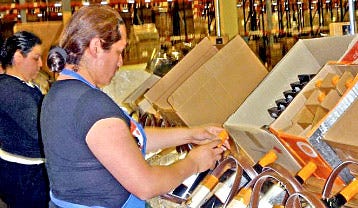
1-800 Flowers 2
When creating boxes for premium-brand products, DesignPac graphic artists work with the brand owners to deliver designs that ring true to the product’s branding, but still provide a coherent look to the packaged gift set. Brand owners often will give DesignPac ‘s designers a color palette to work within and general brand guidelines.After designs are finalized, files are prepared for printing by an outside converter. As part of a new initiative launched by 1-800-Flowers.com, all of DesignPac’s paperboard box printing and converting jobs are awarded by reverse auction.
“Basically, we post all the package printing that we are going to need for the entire year though this site run through an Oracle database,” Jensen explains. “We invite about 20 different vendors to bid. They can all see how they fall in relation to each other. They don’t know who each other is; they don’t know the companies involved. But they can see what their bid was and here’s the lowest bid, and do I want to take this down a couple cents to be the lowest bid, or am I rock-bottom right now, and I can’t do that?”
With all this attention paid to the individual basket components’ packaging, it’s not surprising that DesignPac would want any adhesive used for the basket to not only keep all the components in place but also not damage the boxes upon separation by a consumer.
A not-so-sticky situation
This is not an easy goal, especially when considering the productivity needs of the high-volume operation. Gourmet food and gift baskets brought in $24.7 million in revenue for 1-800-Flowers.com Inc. during the first quarter of the 2010 fiscal year alone.
“Years ago we used clear tape and tried to tape the components in position,” recalls David M. French , vp of operations for DesignPac.
To increase the productivity of its packaging line, DesignPac adopted the use of a pre-engineered adhesive patch (PEAP) to hold the products in place. This product enabled the packaging line workers to quickly secure a gift basket’s many individual package products together without marring the appearance of the products with tape. Unfortunately, the first adhesive chosen did not live up to DesignPac’s expectations.
“We used the thick round adhesive dots for a while, and we had a lot of issues with those,” remarks Scott Jensen, director of packaging engineering and procurement, DesignPac. “Over time, they tend to dry out because of their high profile. They would start to lose their tack, and stuff started falling out of place.”
Heated complication
When packing the Sonoma Wine Gift Basket or gifts like it, the search for a strong-yet-pliable adhesive is further complicated by the packing process.
Utilizing an ERP system, product inventory is managed for the gift to ensure timely delivery of prepacked components. as well as product received in bulk to be placed into custom-made primary packaging.
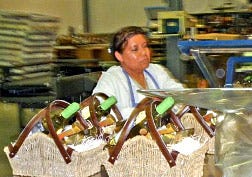
1-800 Flowers 3
To prevent bottlenecks on the main packing lines, bulk product and the custom-made paperboard cartons are first brought to an off-line packing area. At the Melrose Park facility, there are four off-line packing stations. Each station is manned by two operators, who erect printed boxes and fill them with product delivered in bulk. These filled packages are then manually placed into production bins.Production bins of filled boxes and prepacked products are then staged above an Automated Conveyor Systems Inc. production belt. The reusable outer package, usually a basket or box, is loaded at the end of the line.
The first line worker preps the basket or box base with a vacuum-form insert, riser or fill such as shred, crinkle grass or parchment. The thermoformed inserts give baskets going to retailers, such as Costco, more shelf-impact by propping the individual gift items up and enabling consumers to more easily view them.
For baskets that will be shipped through the major carriers, such as FedEx, the items are intentionally packed further into the box. Therefore, the boxes are usually designed with a small riser or fill instead. Packing the items further into the baskets affords the individual gift items more protection during the shipping process.
A sample gift set is staged at the production line so workers can view the exact placement of each item as specified by the gift set designers. Each worker then is assigned a specific task, with a maximum time to complete of four seconds.
Mounted on the side of the conveyor below the belt are rolls of PEAP adhesives. Workers remove the appropriate PEAP from its liner, then taps the adhesive patch onto the individually packaged item. The individually packaged items are positioned into the basket or box as it travels down the conveyor.
After many of the gift sets are built with all of its individual packaged components, they are shrink-wrapped. First, a worker places the film over the completed gift set. The film is then cut and bottom sealed. The gift set is then placed through a Shanklin heat tunnel. This is another area where using the wrong adhesive could result in product damage.
Jensen explains that there is a “fine line” between having an adhesive strong enough to hold products in place when traveling to a shrink tunnel and an adhesive pliable enough after being heated in the shrink tunnel to enable a consumer to easily pull components apart.
To walk this fine line Jensen wanted an adhesive product that was more specialized than a stock item out of a company catalog, so he contacted RS Industrial.
Like-minded approach
“Scott Jensen’s an engineer from Michigan State, and the CEO of our company is a chemist,” comments Steve Saville, president of RS Industrial. “So, we shared similar views on how we would go about improving the process.”
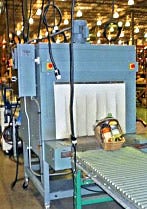
1-800 Flowers heat tunnel
Working together, the companies experimented with different formulations and shapes offered in RS Industrial’s Adhesive Squares product line. They created two optimized versions of the adhesives—one version had a more permanent adhesion and the other was designed to be more easily removed.Different shapes also were developed for different products, such as the wine bottle. “Adhesive Squares is a trademark name but the dimensions [of the adhesive patch] can vary in length, height and width,” Saville explains. “When we customize a product, we first work on the adhesives then we look at the shape which maximizes the usefulness of the product. For example, a wine bottle is curved so it will stick differently than a square box that is being used in a gift tower.”
The products also were designed for speedy application on DesignPac gift-packing lines. With the new adhesive solution in place, DesignPac has set a four-second motion goal for all of its packing processes. “An employee has four seconds to grab the item, tap the adhesive square on the item and position it in the box,” French explains.
Refining the process
Jensen and French are now working on further refinements to the packing process. French is working with his operations team to optimize dispensing of the patches on the lines. At time of publication, several roll mounting and dispensing configurations were being tested. Jensen is working with RS Industrial to develop a way for line workers to quickly and easily identify the different adhesive patch formulations.
MORE INFORMATION IS AVAILABLE:
RS Industrial, 800/844-1740. www.rsindustrial.com
Automated Conveyor Systems Inc., 870/732-5050. www.automatedconveyors.com
Highlight Industries, 800/531-2465. www.highlightindustries.com
Lantech, 800/866-0322. www.lantech.com
Shanklin, a Sealed Air Corp. brand, 866/773-4567. www.sealedair.com
.
About the Author(s)
You May Also Like


